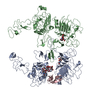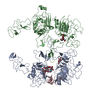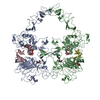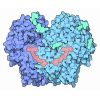+ Open data
Open data
- Basic information
Basic information
| Entry | Database: PDB / ID: 8hgs | ||||||
|---|---|---|---|---|---|---|---|
| Title | The EGF-bound EGFR ectodomain homodimer | ||||||
 Components Components |
| ||||||
 Keywords Keywords |  MEMBRANE PROTEIN MEMBRANE PROTEIN | ||||||
| Function / homology |  Function and homology information Function and homology informationnegative regulation of secretion / positive regulation of hyaluronan biosynthetic process / negative regulation of cholesterol efflux / positive regulation of cerebellar granule cell precursor proliferation / cerebellar granule cell precursor proliferation / regulation of calcium ion import / positive regulation of protein localization to early endosome / regulation of protein localization to cell surface / positive regulation of epithelial tube formation / positive regulation of ubiquitin-dependent protein catabolic process ...negative regulation of secretion / positive regulation of hyaluronan biosynthetic process / negative regulation of cholesterol efflux / positive regulation of cerebellar granule cell precursor proliferation / cerebellar granule cell precursor proliferation / regulation of calcium ion import / positive regulation of protein localization to early endosome / regulation of protein localization to cell surface / positive regulation of epithelial tube formation / positive regulation of ubiquitin-dependent protein catabolic process / response to hydroxyisoflavone /  multivesicular body, internal vesicle lumen / positive regulation of prolactin secretion / negative regulation of cardiocyte differentiation / positive regulation of protein kinase C activity / diterpenoid metabolic process / Shc-EGFR complex / multivesicular body, internal vesicle lumen / positive regulation of prolactin secretion / negative regulation of cardiocyte differentiation / positive regulation of protein kinase C activity / diterpenoid metabolic process / Shc-EGFR complex /  ovulation cycle / regulation of receptor signaling pathway via JAK-STAT / Inhibition of Signaling by Overexpressed EGFR / ovulation cycle / regulation of receptor signaling pathway via JAK-STAT / Inhibition of Signaling by Overexpressed EGFR /  epidermal growth factor receptor activity / EGFR interacts with phospholipase C-gamma / positive regulation of mucus secretion / response to UV-A / epidermal growth factor receptor activity / EGFR interacts with phospholipase C-gamma / positive regulation of mucus secretion / response to UV-A /  epidermal growth factor binding / PLCG1 events in ERBB2 signaling / tongue development / midgut development / ERBB2-EGFR signaling pathway / hydrogen peroxide metabolic process / NFE2L2 regulating tumorigenic genes / PTK6 promotes HIF1A stabilization / digestive tract morphogenesis / epidermal growth factor binding / PLCG1 events in ERBB2 signaling / tongue development / midgut development / ERBB2-EGFR signaling pathway / hydrogen peroxide metabolic process / NFE2L2 regulating tumorigenic genes / PTK6 promotes HIF1A stabilization / digestive tract morphogenesis /  regulation of nitric-oxide synthase activity / regulation of nitric-oxide synthase activity /  epidermal growth factor receptor binding / ERBB2 Activates PTK6 Signaling / morphogenesis of an epithelial fold / intracellular vesicle / branching morphogenesis of an epithelial tube / Signaling by EGFR / response to cobalamin / negative regulation of epidermal growth factor receptor signaling pathway / epidermal growth factor receptor binding / ERBB2 Activates PTK6 Signaling / morphogenesis of an epithelial fold / intracellular vesicle / branching morphogenesis of an epithelial tube / Signaling by EGFR / response to cobalamin / negative regulation of epidermal growth factor receptor signaling pathway /  transmembrane receptor protein tyrosine kinase activator activity / protein tyrosine kinase activator activity / Signaling by ERBB4 / regulation of phosphatidylinositol 3-kinase/protein kinase B signal transduction / protein insertion into membrane / eyelid development in camera-type eye / cerebral cortex cell migration / ERBB2 Regulates Cell Motility / regulation of JNK cascade / positive regulation of receptor internalization / activation of phospholipase C activity / positive regulation of cyclin-dependent protein serine/threonine kinase activity / PI3K events in ERBB2 signaling / negative regulation of mitotic cell cycle / hair follicle development / transmembrane receptor protein tyrosine kinase activator activity / protein tyrosine kinase activator activity / Signaling by ERBB4 / regulation of phosphatidylinositol 3-kinase/protein kinase B signal transduction / protein insertion into membrane / eyelid development in camera-type eye / cerebral cortex cell migration / ERBB2 Regulates Cell Motility / regulation of JNK cascade / positive regulation of receptor internalization / activation of phospholipase C activity / positive regulation of cyclin-dependent protein serine/threonine kinase activity / PI3K events in ERBB2 signaling / negative regulation of mitotic cell cycle / hair follicle development /  MAP kinase kinase kinase activity / Estrogen-dependent nuclear events downstream of ESR-membrane signaling / positive regulation of G1/S transition of mitotic cell cycle / embryonic placenta development / mammary gland alveolus development / positive regulation of bone resorption / positive regulation of DNA binding / GAB1 signalosome / positive regulation of nitric oxide mediated signal transduction / salivary gland morphogenesis / regulation of peptidyl-tyrosine phosphorylation / peptidyl-tyrosine autophosphorylation / positive regulation of glial cell proliferation / positive regulation of phosphorylation / positive regulation of vasoconstriction / Signaling by ERBB2 / cellular response to epidermal growth factor stimulus / ERK1 and ERK2 cascade / cellular response to cadmium ion / positive regulation of DNA repair / GRB2 events in EGFR signaling / SHC1 events in EGFR signaling / EGFR Transactivation by Gastrin / TFAP2 (AP-2) family regulates transcription of growth factors and their receptors / GRB2 events in ERBB2 signaling / positive regulation of endothelial cell proliferation / MAP kinase kinase kinase activity / Estrogen-dependent nuclear events downstream of ESR-membrane signaling / positive regulation of G1/S transition of mitotic cell cycle / embryonic placenta development / mammary gland alveolus development / positive regulation of bone resorption / positive regulation of DNA binding / GAB1 signalosome / positive regulation of nitric oxide mediated signal transduction / salivary gland morphogenesis / regulation of peptidyl-tyrosine phosphorylation / peptidyl-tyrosine autophosphorylation / positive regulation of glial cell proliferation / positive regulation of phosphorylation / positive regulation of vasoconstriction / Signaling by ERBB2 / cellular response to epidermal growth factor stimulus / ERK1 and ERK2 cascade / cellular response to cadmium ion / positive regulation of DNA repair / GRB2 events in EGFR signaling / SHC1 events in EGFR signaling / EGFR Transactivation by Gastrin / TFAP2 (AP-2) family regulates transcription of growth factors and their receptors / GRB2 events in ERBB2 signaling / positive regulation of endothelial cell proliferation /  transmembrane receptor protein tyrosine kinase activity / transmembrane receptor protein tyrosine kinase activity /  neurogenesis / cellular response to dexamethasone stimulus / SHC1 events in ERBB2 signaling / neurogenesis / cellular response to dexamethasone stimulus / SHC1 events in ERBB2 signaling /  ossification / positive regulation of synaptic transmission, glutamatergic / guanyl-nucleotide exchange factor activity / basal plasma membrane / regulation of ERK1 and ERK2 cascade / positive regulation of mitotic nuclear division / neuron projection morphogenesis / positive regulation of endothelial cell migration / positive regulation of superoxide anion generation / platelet alpha granule lumen / positive regulation of DNA replication / positive regulation of peptidyl-threonine phosphorylation / Signal transduction by L1 ossification / positive regulation of synaptic transmission, glutamatergic / guanyl-nucleotide exchange factor activity / basal plasma membrane / regulation of ERK1 and ERK2 cascade / positive regulation of mitotic nuclear division / neuron projection morphogenesis / positive regulation of endothelial cell migration / positive regulation of superoxide anion generation / platelet alpha granule lumen / positive regulation of DNA replication / positive regulation of peptidyl-threonine phosphorylation / Signal transduction by L1Similarity search - Function | ||||||
| Biological species |   Homo sapiens (human) Homo sapiens (human) | ||||||
| Method |  ELECTRON MICROSCOPY / ELECTRON MICROSCOPY /  single particle reconstruction / single particle reconstruction /  cryo EM / Resolution: 3.81 Å cryo EM / Resolution: 3.81 Å | ||||||
 Authors Authors | Zhang, Z. / Bai, X. | ||||||
| Funding support |  China, 1items China, 1items
| ||||||
 Citation Citation |  Journal: Cell Discov / Year: 2023 Journal: Cell Discov / Year: 2023Title: Structure and dynamics of the EGFR/HER2 heterodimer. Authors: Xue Bai / Pengyu Sun / Xinghao Wang / Changkun Long / Shuyun Liao / Song Dang / Shangshang Zhuang / Yongtao Du / Xinyi Zhang / Nan Li / Kangmin He / Zhe Zhang /  Abstract: HER2 belongs to the human epidermal growth factor receptor tyrosine kinase family. Its overexpression or hyperactivation is a leading cause for multiple types of cancers. HER2 functions mainly ...HER2 belongs to the human epidermal growth factor receptor tyrosine kinase family. Its overexpression or hyperactivation is a leading cause for multiple types of cancers. HER2 functions mainly through dimerization with other family members, such as EGFR. However, the molecular details for heterodimer assembly have not been completely understood. Here, we report cryo-EM structures of the EGF- and epiregulin-bound EGFR/HER2 ectodomain complexes at resolutions of 3.3 Å and 4.5 Å, respectively. Together with the functional analyses, we demonstrate that only the dimerization arm of HER2, but not that of EGFR, is essential for their heterodimer formation and signal transduction. Moreover, we analyze the differential membrane dynamics and transient interactions of endogenous EGFR and HER2 molecules in genome-edited cells using single-molecule live-cell imaging. Furthermore, we show that the interaction with HER2 could allow EGFR to resist endocytosis. Together, this work deepens our understanding of the unique structural properties and dynamics of the EGFR/HER2 complex. | ||||||
| History |
|
- Structure visualization
Structure visualization
| Structure viewer | Molecule:  Molmil Molmil Jmol/JSmol Jmol/JSmol |
|---|
- Downloads & links
Downloads & links
- Download
Download
| PDBx/mmCIF format |  8hgs.cif.gz 8hgs.cif.gz | 313.5 KB | Display |  PDBx/mmCIF format PDBx/mmCIF format |
|---|---|---|---|---|
| PDB format |  pdb8hgs.ent.gz pdb8hgs.ent.gz | 240.6 KB | Display |  PDB format PDB format |
| PDBx/mmJSON format |  8hgs.json.gz 8hgs.json.gz | Tree view |  PDBx/mmJSON format PDBx/mmJSON format | |
| Others |  Other downloads Other downloads |
-Validation report
| Arichive directory |  https://data.pdbj.org/pub/pdb/validation_reports/hg/8hgs https://data.pdbj.org/pub/pdb/validation_reports/hg/8hgs ftp://data.pdbj.org/pub/pdb/validation_reports/hg/8hgs ftp://data.pdbj.org/pub/pdb/validation_reports/hg/8hgs | HTTPS FTP |
|---|
-Related structure data
| Related structure data |  34746MC  8hgoC  8hgpC M: map data used to model this data C: citing same article ( |
|---|---|
| Similar structure data | Similarity search - Function & homology  F&H Search F&H Search |
- Links
Links
- Assembly
Assembly
| Deposited unit | 
|
|---|---|
| 1 |
|
- Components
Components
| #1: Protein |  / Proto-oncogene c-ErbB-1 / Receptor tyrosine-protein kinase erbB-1 / Proto-oncogene c-ErbB-1 / Receptor tyrosine-protein kinase erbB-1Mass: 81075.297 Da / Num. of mol.: 2 Source method: isolated from a genetically manipulated source Source: (gene. exp.)   Homo sapiens (human) / Gene: EGFR, ERBB, ERBB1, HER1 / Cell line (production host): HEK293S GnTI- / Production host: Homo sapiens (human) / Gene: EGFR, ERBB, ERBB1, HER1 / Cell line (production host): HEK293S GnTI- / Production host:   Homo sapiens (human) Homo sapiens (human)References: UniProt: P00533,  receptor protein-tyrosine kinase receptor protein-tyrosine kinase#2: Protein | Mass: 6555.376 Da / Num. of mol.: 2 Source method: isolated from a genetically manipulated source Source: (gene. exp.)   Homo sapiens (human) / Gene: EGF / Production host: Homo sapiens (human) / Gene: EGF / Production host:   Escherichia coli (E. coli) / References: UniProt: P01133 Escherichia coli (E. coli) / References: UniProt: P01133#3: Polysaccharide | Type: oligosaccharide  / Mass: 748.682 Da / Num. of mol.: 2 / Mass: 748.682 Da / Num. of mol.: 2Source method: isolated from a genetically manipulated source #4: Sugar | ChemComp-NAG /  N-Acetylglucosamine N-AcetylglucosamineHas ligand of interest | Y | |
|---|
-Experimental details
-Experiment
| Experiment | Method:  ELECTRON MICROSCOPY ELECTRON MICROSCOPY |
|---|---|
| EM experiment | Aggregation state: PARTICLE / 3D reconstruction method:  single particle reconstruction single particle reconstruction |
- Sample preparation
Sample preparation
| Component | Name: EGF-bound EGFR ectodomain homodimer / Type: COMPLEX / Entity ID: #1-#2 / Source: RECOMBINANT |
|---|---|
| Molecular weight | Value: 0.2 MDa / Experimental value: NO |
| Source (natural) | Organism:   Homo sapiens (human) Homo sapiens (human) |
| Source (recombinant) | Organism:   Homo sapiens (human) / Cell: HEK293S GnTI- Homo sapiens (human) / Cell: HEK293S GnTI- |
| Buffer solution | pH: 7.5 |
| Specimen | Conc.: 4.2 mg/ml / Embedding applied: NO / Shadowing applied: NO / Staining applied : NO / Vitrification applied : NO / Vitrification applied : YES : YES |
Vitrification | Cryogen name: ETHANE / Humidity: 100 % / Chamber temperature: 277 K |
- Electron microscopy imaging
Electron microscopy imaging
| Experimental equipment |  Model: Titan Krios / Image courtesy: FEI Company |
|---|---|
| Microscopy | Model: FEI TITAN KRIOS |
| Electron gun | Electron source : :  FIELD EMISSION GUN / Accelerating voltage: 300 kV / Illumination mode: FLOOD BEAM FIELD EMISSION GUN / Accelerating voltage: 300 kV / Illumination mode: FLOOD BEAM |
| Electron lens | Mode: BRIGHT FIELD Bright-field microscopy / Nominal defocus max: 1500 nm / Nominal defocus min: 1200 nm Bright-field microscopy / Nominal defocus max: 1500 nm / Nominal defocus min: 1200 nm |
| Image recording | Electron dose: 60.8 e/Å2 / Film or detector model: GATAN K3 (6k x 4k) |
- Processing
Processing
| EM software |
| ||||||||||||||||||||||||
|---|---|---|---|---|---|---|---|---|---|---|---|---|---|---|---|---|---|---|---|---|---|---|---|---|---|
CTF correction | Type: NONE | ||||||||||||||||||||||||
3D reconstruction | Resolution: 3.81 Å / Resolution method: FSC 0.143 CUT-OFF / Num. of particles: 196557 / Symmetry type: POINT | ||||||||||||||||||||||||
| Atomic model building | Protocol: FLEXIBLE FIT / Space: REAL | ||||||||||||||||||||||||
| Refine LS restraints |
|
 Movie
Movie Controller
Controller





 PDBj
PDBj



















